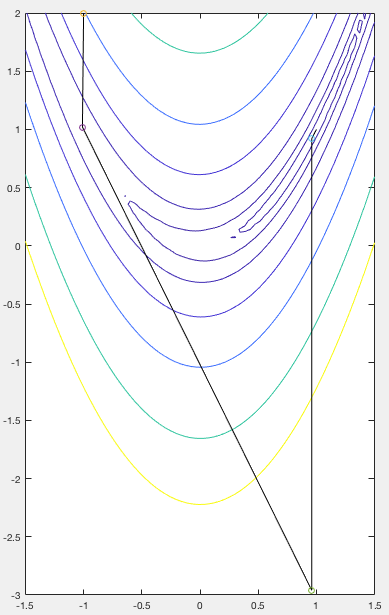Next: Quasi-Newton Methods Up: Unconstrained Optimization Previous: Gradient Descent Method
In general, in an algorithm for minimizing an objective function







First we realize that the search direction 






 |
(51) |
 and Newton's method with
and Newton's method with
 :
:
 |
(52) |
 is assumed to be positive definite so that a
minimum exists.
is assumed to be positive definite so that a
minimum exists.
Next, we need to find the optimal step size 




 at the next point
at the next point
 should be perpendicular to the search direction
should be perpendicular to the search direction  . In
other words, when traversing along
. In
other words, when traversing along  , we should stop at
the point
, we should stop at
the point
 at which the
gradient
at which the
gradient
 is perpendicular to
is perpendicular to  , i.e.,
it has zero component along
, i.e.,
it has zero component along  , and the corresponding
, and the corresponding
 is the optimal step size.
is the optimal step size.
To find the actual optimal step size 




![$\displaystyle \left[f({\bf x}_n+\delta{\bf d}_n)\right]_{\delta=0}$](img314.svg) |
 |
 |
(55) |
![$\displaystyle \left[\frac{d}{d\delta}f({\bf x}_n+\delta{\bf d}_n)\right]_{\delta=0}$](img316.svg) |
 |
![$\displaystyle \left[{\bf g}({\bf x}_n+\delta{\bf d}_n)^T{\bf d}_n\right]_{\delta=0}
={\bf g}^T_n{\bf d}_n$](img317.svg) |
(56) |
![$\displaystyle \left[\frac{d^2}{d\delta^2}f({\bf x}_n+\delta{\bf d}_n)\right]_{\delta=0}$](img318.svg) |
 |
![$\displaystyle \left[\frac{d}{d\delta}{\bf g}({\bf x}_n
+\delta{\bf d}_n)^T\righ...
...})\;
\frac{d}{d\delta}({\bf x}_n+\delta{\bf d}_n)\right]^T_{\delta=0}
{\bf d}_n$](img319.svg) |
|
 |
 |
(57) |
 is the Hessian matrix of
is the Hessian matrix of
 at
at  . Substituting these back into the Taylor series above
we get:
. Substituting these back into the Taylor series above
we get:
 |
(58) |
 that minimizes
that minimizes
 , we
set its derivative with respect to
, we
set its derivative with respect to  to zero:
to zero:
 to get the optimal
step size based on both
to get the optimal
step size based on both  and
and  :
:
Based on this result, we can find the optimal step side for the Newton's method and gradient descent method considered previously:
The search direction is

 |
(61) |
 |
(62) |
The search direction is

 i.e., i.e., |
(63) |
 is always
perpendicular to the previous one
is always
perpendicular to the previous one
 , i.e., the
iteration follows a zigzag path composed of a sequence of segments
from the initial guess to the final solution. The optimal step size
is
, i.e., the
iteration follows a zigzag path composed of a sequence of segments
from the initial guess to the final solution. The optimal step size
is
Given 








![$\displaystyle \left[\frac{d^2}{d\delta^2} f({\bf x}+\delta{\bf d})\right]_{\delta=0}$](img338.svg) |
 |
![$\displaystyle \left[\frac{d}{d\delta} f'({\bf x}+\delta{\bf d})\right]_{\delta=...
...\lim_{\sigma\rightarrow 0}
\frac{f'({\bf x}+\sigma{\bf d})-f'({\bf x})}{\sigma}$](img339.svg) |
|
 |
 |
(65) |
 and
and
 .
This approximation can be used to replace
.
This approximation can be used to replace
 in Eq. (59) abve:
in Eq. (59) abve:
 |
(66) |
 we get the estimated optimal step size:
we get the estimated optimal step size:
 |
(67) |
 ,
this optimal step size becomes:
and the iteration becomes
,
this optimal step size becomes:
and the iteration becomes
 |
(69) |
Example:
The gradient descent method applied to solve the same three-variable equation system previously solved by Newton's method:
 |
The step size 


 |
 , and
With 500 additional iterations the algorithm converges to the
following approximated solution with accuracy of
, and
With 500 additional iterations the algorithm converges to the
following approximated solution with accuracy of
 :
:
![$\displaystyle {\bf x}^*=\left[\begin{array}{r}
0.5000013623816102\\
0.0040027495837189\\
-0.4999000311539049\end{array}\right]$](img352.svg) |
(70) |
When it is difficult or too computationally costly to find the
optimal step size along the search direction, some suboptimal
step size may be acceptable, such as in the
quasi-Newton methods
for minimization problems. In this case, although the step size




 |
(71) |
 |
(72) |
 , this condition can also be written
in the following alternative form:
, this condition can also be written
in the following alternative form:
 |
(73) |
 and
and  above satisfy
above satisfy
 .
.
In general, these conditions are motivated by the desired effect
that after each iterative step, the function should have a shallower
slope along 

Specifically, to understand the first condition above, we represent
the function to be minimized as a single-variable function of the
step size








 |
(74) |
 . Now the
function of the tangent line can be written as
. Now the
function of the tangent line can be written as
 |
(75) |
 of
slope zero, we see that any straight line between
of
slope zero, we see that any straight line between
 and
and
 can be described by
can be described by
 with
with
 , with a slope
, with a slope
 .
The Armijo rule is to find any
.
The Armijo rule is to find any  that satisfies
that satisfies
 |
(76) |
 is guaranteed to be reduced.
is guaranteed to be reduced.
The second condition requires that at the new position





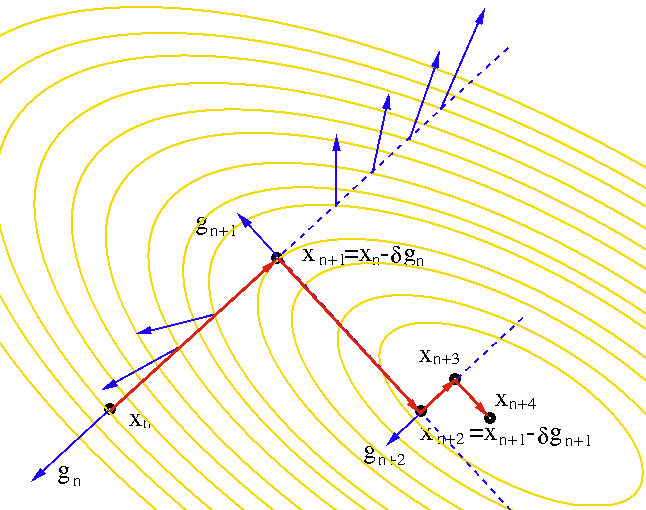
The reason why









The gradient descent method gradually approaches a solution 

To improve the performance of the gradient descent method we can include in the iteration a momentum term representing the search direction previously traversed:
 |
(77) |
 controls how much momentum is to
be added.
controls how much momentum is to
be added.
Obviously it is most desirable not to repeat any of the previous directions traveled so that the solution can be reached in N steps, each in a unique direction in the N-D space. In other words, the subsequent steps are independent of each other, never interfering with the results achieved in the previous steps. Such a method will be discussed in the next section.
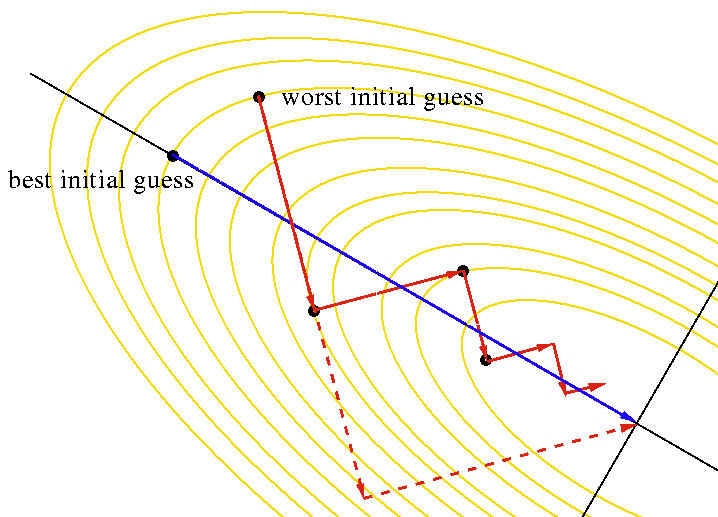
Example:
The Rosenbrock function
  |
 at the point
at the point  , which is inside a long parabolic
shaped valley as shown in the figure below. As the slope along the
valley is very shallow, it is difficult for an algorithm to converge
quickly to the minimum. For this reason, the Rosenbrock function is
often used to test various minimization algorithms.
, which is inside a long parabolic
shaped valley as shown in the figure below. As the slope along the
valley is very shallow, it is difficult for an algorithm to converge
quickly to the minimum. For this reason, the Rosenbrock function is
often used to test various minimization algorithms.
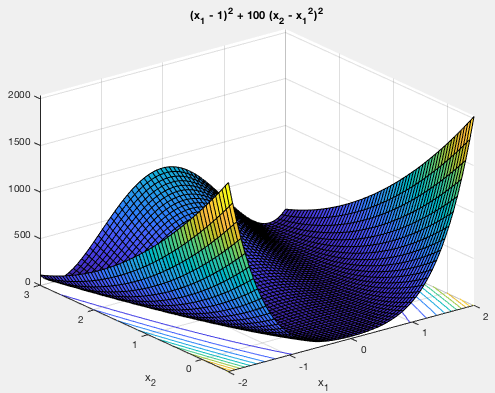
The figure below shows the search path of the gradient descent method based on the optimal step size given in Eq. (64). We see that the search path is composed a long sequence of 90 degree turns between consecutive segments.
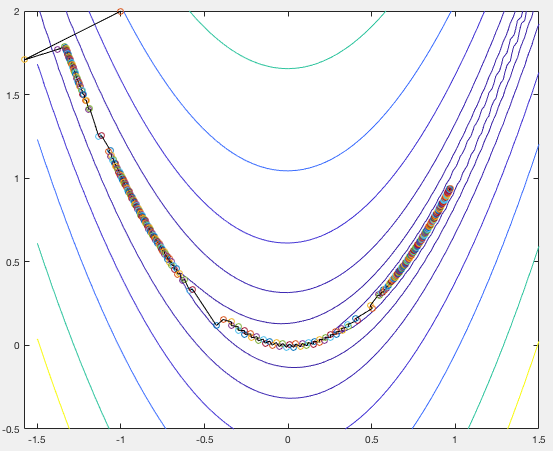
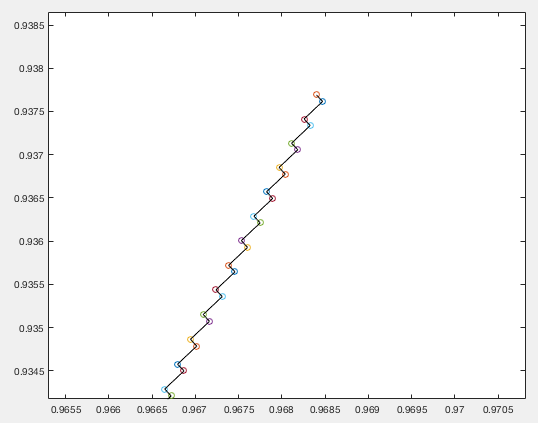
When the Newton's method is applied to this minimization problem, it takes only four iterations for the algorithm to converge to the minimum, as shown in the figure below:
